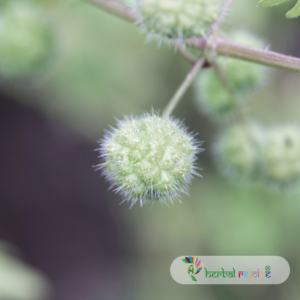Introduction
Roman Nettle, scientifically known as Urtica pilulifera Linn., is a medicinal plant belonging to the Urticaceae family. It is predominantly found in Simla and other hill stations. In the English language, it is commonly called Roman Nettle, and it is recognized in Ayurveda as a substitute for Vrishchiyaa-shaaka. In Unani medicine, it is known as Anjuraa. This article explores the various actions and properties of Roman Nettle, highlighting its potential as a diuretic, astringent, and haemostatic herb.
Description and Habitat
Roman Nettle thrives in the cool climate of hill stations such as Simla. It is a perennial plant with leaves and stems that contain an indole alkaloid called bufotenin. The plant also contains a significant amount of 5-hydroxytryptamine, primarily located in the strings of the leaves.
Other Varieties
Alongside Roman Nettle, another variety known as Urtica urens Linn. or Dog Nettle is found in Dehra Dun and Udhampur district of J. & K. This variety contains various flavonoid compounds like kaempferol, isorhamnetin, quercetin, apigenin, diosmetin, and luteolin. It is worth mentioning that Dog Nettle also contains chlorogenic acid.

Health Benefits and Actions
1. Diuretic Action: Roman Nettle has diuretic properties, meaning it promotes increased urine production. This action can be beneficial in promoting kidney health and clearing the body of toxins and waste.
2. Astringent Action: The astringent properties of Roman Nettle make it useful in toning and tightening tissues. It can be particularly helpful in managing conditions such as diarrhea and excessive bleeding.
3. Haemostatic Action: Roman Nettle exhibits haemostatic activities, which means it assists in blood clotting. This property can aid in controlling bleeding and promoting wound healing.
Prostate Health
Additionally, Roman Nettle has shown promise in improving mild cases of prostate enlargement, especially in men over the age of 60. The fluid extract derived from the plant’s roots has been found to improve micturition symptoms in such cases. However, further research is required to establish its efficacy and safety.
Conclusion
Roman Nettle (Urtica pilulifera Linn.) is a versatile medicinal plant with diuretic, astringent, and haemostatic actions. Its indole alkaloid content and the presence of 5-hydroxytryptamine in its leaves and stems make it a valuable natural remedy. Additionally, Dog Nettle (Urtica urens Linn.) exhibits several flavonoid compounds and chlorogenic acid, offering potential health benefits. Both varieties have their unique properties and potential applications in traditional medicine. Further research is needed to validate and explore the efficacy and safety of these plants fully. Incorporating Roman Nettle into one’s wellness routine may offer natural support for urinary health and other related conditions.
Frequently Asked Questions
What is Roman Nettle?
Roman Nettle, scientifically known as Urtica pilulifera Linn., is a perennial medicinal plant from the Urticaceae family. It is commonly found in hill stations like Simla and is used in traditional Ayurvedic and Unani medicine.
What are the medicinal properties of Roman Nettle?
Roman Nettle has diuretic, astringent, and haemostatic properties. It helps increase urine production, tones tissues, controls excessive bleeding, and aids in blood clotting.
What is Roman Nettle used for in traditional medicine?
Traditionally, Roman Nettle is used to promote kidney health, manage diarrhea and excessive bleeding, and aid in wound healing due to its blood-clotting properties. It is also used in mild cases of prostate enlargement in older men.
What are the main active compounds found in Roman Nettle?
Roman Nettle contains the indole alkaloid bufotenin and 5-hydroxytryptamine in its leaves and stems. These compounds contribute to its medicinal properties.
How does Roman Nettle benefit prostate health?
Roman Nettle has been found to improve mild cases of prostate enlargement, particularly in men over 60. The fluid extract from the plant’s roots can help alleviate urinary symptoms, although more research is needed to confirm this effect.
What is the difference between Roman Nettle and Dog Nettle?
Dog Nettle (Urtica urens Linn.) is another variety of nettle found in regions like Dehra Dun. While Roman Nettle contains bufotenin and 5-hydroxytryptamine, Dog Nettle is rich in flavonoid compounds like kaempferol, quercetin, and chlorogenic acid.


